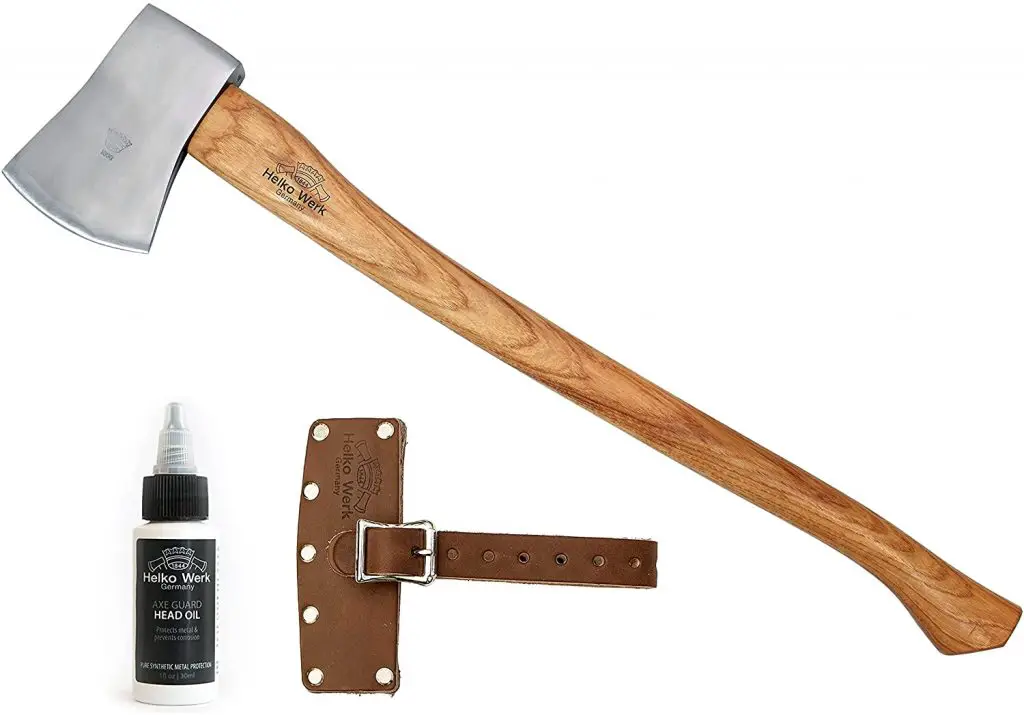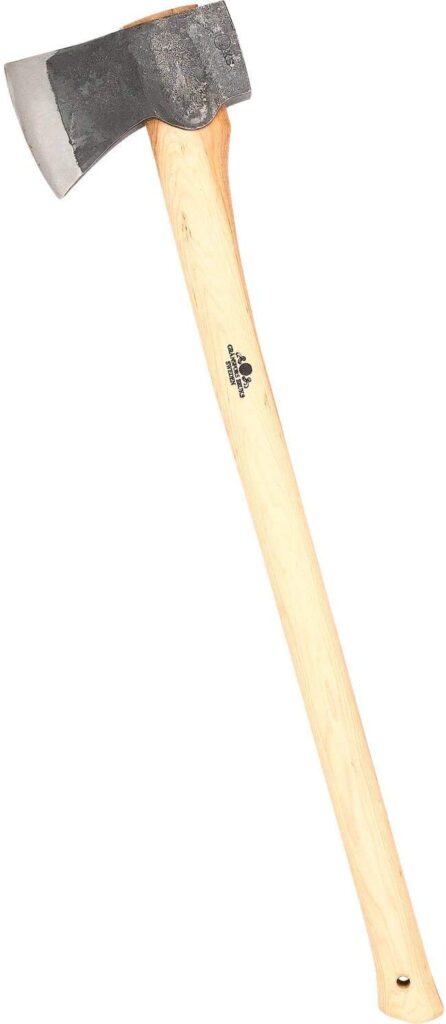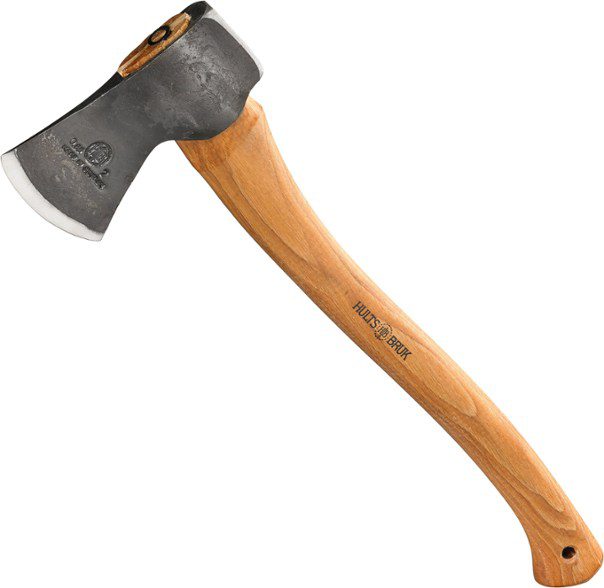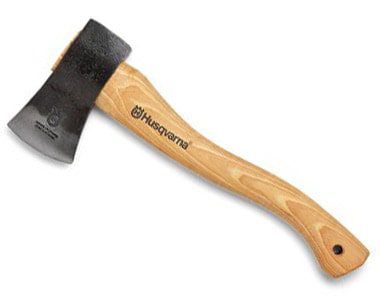An axe and a hatchet differ in size, head shape, and purpose. Hatchets are compact with pronounced taper for precision tasks, while axes are larger with subtle taper for heavier-duty chopping and splitting.
Axes are much larger that weigh over 3 pounds with a 20 to 36-inch handle, while a hatchet is smaller and weighs between 1 to 3 pounds and is between 12 and 18 inches in length.
Axes are used for felling trees and splitting logs, while hatchets are better suited for preparing kindling or carving wood.
A cutting tool is a must-have in your shed for chopping wood or doing DIY wood projects, no matter which part of the world you live in. In almost every hardware store, you’ll find several types of cutting tools, including axes and hatchets.
As the tools are almost similar in appearance, it’s tough to pick one per your needs. Yet, understanding axe vs. hatchet differences is crucial as you can’t use axes as a substitute for hatchets. You can use an axe to chop wood, but only hatchets are suitable for outdoor camping.
To assist you in finding the right tool, we have narrowed down the key differences in the appearance, types, and usage of axes and hatchets. Without wasting any time, let’s get rolling.
Table of Contents
Comparison Chart: Axe vs Hatchet
In a hurry? Then have a quick look at the basic differences between an Axe and a hatchet:
| Features | Axe | Hatchet |
| Head Design | Heavy, wedge-shaped with a flat poll side | Heavy, features a V-shaped cut and a hammer-like poll side |
| Shaft Structure | Double-handed use, 20″ -36″ length, no curve | Single-handed use, 12″ -18″ length, curved structure |
| Weight | Heavy, minimum 3 pounds | Heavy, 1-3 pounds |
| Usage | Chopping trees, splitting wood logs, shaping wood, etc. | Cut softwood, hunting, axe-throwing, etc. |
What Is an Axe?
Axe is the most common cutting tool worldwide, featuring a long wood-made shaft and a metal wedge at one end of the shaft. The tool is used mainly for chopping tree branches and splitting wood.
Since the metal wedge is made from heavy metal, it helps you cut any rigid object without applying much force. The wedge blades have sharp and tapered edges to make the task more convenient. You can identify an axe as the heaviest and longest tool in a hardware store.
1844 Helko Werk Germany Classic Tasmania Competition Axe
- C50 High Carbon Steel Head
- Handmade in Germany
- 31 Inch Grade A American Hickory Handle
- 4 Pound Axehead / 6 Pound Total Weight
- 31-inch Hickory Handle
- Hand Forged 3.3 lb Axehead
- 20 Year Warranty
- Made in Sweden from the World's Premier Forge
- Total Weight - 2.75 pounds
- 2.0 Pound Solid Swedish Steel Axehead
- 20 inch American Hickory Handle
- Ideal for Bushcrafting and Camping
What Is a Hatchet?
A hatchet is usually regarded as a smaller version of a regular axe. The fundamental difference is that hatchets are more compact with heavier blades and smaller shafts featuring curves and grooves. Most hatchets have a V-shaped cut on their blade that separates the tool from other axes.
Because of the short length of the tool, it is suitable for cutting smaller wood pieces and carrying in your backpack for hiking and camping.
You will often hear a hatchet called a hand axe.
- Extremely Durable Design
- Carbon Steel Head and Full-Tang Design
- Shock Reduction Composite Handle
- Lifetime Warranty
- One-Piece Forged Steel Design
- Available in Multiple Colors
- Patented Shocked Reduction Grip
- Made in USA
- Anti-Friction Coating
- Heat Treated Poll for Hammering Tent Pegs
- Powerful Heavy Hatchet at 1.9 Pounds
- Comfortable Non-Slip Grip
Differences between an Axe and Hatchet
The main differences between an axe and a hatchet is that a hatchet has a much shorter shaft, a shorter cutting edge, a flat poll side, and a much lower weight.
Since Axes and hatchets are widely used tools, you’ll notice various features in different brands. However, some basic features are the same in every axe and hatchet. Let’s look at the basic differences between the two tools based on the common traits.
The Shaft
Do you want to identify a hatchet instantly? Just look at the length of the shaft. Compared to most axes, the hatchet is way shorter, with a total length of only 12 to 18 inches. The hatchet is usually regarded as one-handed. It is so compact that you can handle the tool with one hand.
Apart from the length, you can differentiate a hatchet by the curve of its shaft. The defining curve helps you have a stronger grip on the axe handle to cut the wood logs with more precision and safety.
On the other hand, a typical axe has a long shaft with a length of 18 to 34 inches. However, some smaller axes have a shaft length exactly as a hatchet. Axe handles are mainly made from strong wood or fiberglass, whereas hatchet handles are made from metal, wood, or fiberglass.
Although the shaft of some axe types might have some angles, the most common axes usually meet the head at a 90-degree angle. If you can pick up the curved axe with one hand, be sure that’s only a hatchet.
The Head
Most people find many similarities in the head of the axe and hatchet. But if you look closely, you’ll notice the differences. Usually, the head of an axe is 5 to 7 inches long, featuring a very short cutting edge. You might also find some double-bladed axes with two blades on each side.
Unlike the hatchets, the head of an axe is entirely wedge-shaped without any V-like cut. Most axe heads are made from heavy metal to penetrate even the thickest wood. This part of the axe is detachable, so you can change a broken head or handle anytime.
As for the hatchet, the blade is much shorter with a thinner and longer tapered end. You can’t detach the hatchet head from its handle, so the head is made from heavy-duty metal to ensure durability.
The V-shaped funnel is another prominent identifying feature of the hatchet that allows it to pierce thick objects with less effort. Examine the head of a tool to determine whether it’s a hatchet.
The Poll Side
If you fail to spot a hatchet from the shaft or head, the shape of the poll side will surely tell the identity of the tool. A poll side or butt is the opposite side of a blade.
In most hatchets, a hammer-like head on the poll site assists you in driving a nail. When camping, the poll head can help you set up a tent.
On the contrary, an axe never has any hammer-like feature, and it has a flat poll side unsuitable for hammering tasks.
Weight
The regular axes have a bigger size; they weigh more than hatchets. An axe generally weighs more than 3 pounds, whereas a hatchet weighs between 1 and 3 pounds.
The heavier weight of the axes allows you to strike with more power. In contrast, the hatchet is easier to handle and more suitable for carrying on an outing.
Usage
Axes are used for various tasks that mainly involve wood for their outstanding functionality. The primary purpose of using an axe is to cut down a tree and split wood to make houses, benches, shelters, wood boxes, and many other woodcrafts.
Carpenters use their customized axes to give the wood preferred shapes. Different sizes of axes are also used for recreational games like axe-throwing.
Compared to the regular axes, hatchets are much versatile in their functions. They are perfect for all camping tasks, including cutting softwood, clearing trails, hiking, and hunting.
You can also use the hatchet to break hard ice and get clean drinking water. As the tool features a sharper edge, you can use it as a weapon against wild animals.
Conclusion
Well, there you have it all about axe vs hatchet differences. Our guide will hopefully help you spot the little details that make the tools different. If memorizing everything seems too much, here’s a summary for you.
The tool with the longest shaft and plain blade is an axe. If you want to buy a hatchet, you’re looking for a small axe with the smallest shaft and a hammer-like head. As simple as that!








